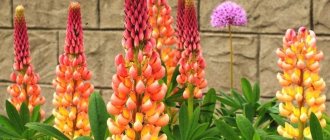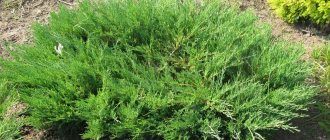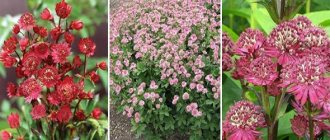Black cohosh: varieties and varieties
This perennial plant owes its unattractive name to the fact that it was previously used as an insecticide. It was believed that the unpleasant odor that the leaves emitted when rubbed repelled bedbugs.
Black cohosh is a fairly easy-to-care plant.
The scientific name - black cohosh - translated from Latin also indicates this property. And only the poetic expression “silver candles,” popular among the Germans, reflects the beauty that black cohosh is endowed with. Planting and care do not require special skills, so it has deservedly gained the love of gardeners.
Attention! Black cohosh is considered a poisonous plant. After contact with it, you should wash your hands thoroughly with soap.
In ornamental gardening and landscape design, 10 of the 15 currently existing varieties of black cohosh are used:
- simple;
- branched;
- Japanese;
- racemose, etc.
These varieties have varieties. They differ in shades not only of flowers, but also of foliage, for example:
- Pink Spike - pinkish inflorescences and dark red leaves.

Variety Pink Spike
- James Compton is a combination of cherry leaves and white flowers.
- White Pearl Leaves are light green in color. Inflorescences are snow-white.
Depending on the species, black cohosh blooms in summer or autumn.
Popular types and varieties
Botanists distinguish 15 varieties of perennials; the following are popular among gardeners:
- Branched (C. ramosa). A perennial of this species grows up to 200 cm in height. During the growing season, small cream-colored flowers appear, which form large oblong-shaped inflorescences. The color of the perennial can be different; the leaves can be bronze, red-chocolate, dark cherry color. Black cohosh blooms in early autumn. If humidity is low during the growing season, the perennial may not have time to form inflorescences. Common varieties:
- Atropurpurea - up to 200 cm in height, the leaves are red-brown in color, but later turn green;
- James Compto - leaves are purple, flowers are snow-white.
- Carbonella - black cohosh has white-pink inflorescences, pinnately divided leaves of a deep red-burgundy hue.
- Simple (C. simplex). Reaches a height of 100 cm, has small inflorescences that are formed by small flowers. Such a perennial may not bloom if there is a large amount of precipitation during the summer. The simple black cohosh includes the "Brunette" variety, which is popular among flower growers due to its bronze-chocolate color. The appearance is complemented by white flowers; when they bloom, they change color to purple. Varieties:
- Armleuchter – flowers are white, this variety has peduncles with strong branching;
- Braunland is a green-brown perennial;
- White Pear - green leaves, with spreading peduncles, white flowers form curved inflorescences.
- Racemose (C. racemose). Comes from North America. The bush is up to 200 cm high, about 50-60 cm wide. Candle-shaped inflorescences (see photo) of black cohosh have a fragrant aroma and bloom from bottom to top. Flowering period – July-September. It is during this period that the shrub is most luxurious, which is due to the blooming white or cream-colored flowers.
- Cordifolia (C. cordifolia). A bush up to one and a half meters high with beautiful pinnately dissected leaves in the shape of a heart. It blooms for a long time with beige racemes up to 30 cm long.
Types of black cohosh in the photo:
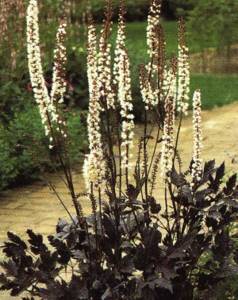
Simple

Cordifolia
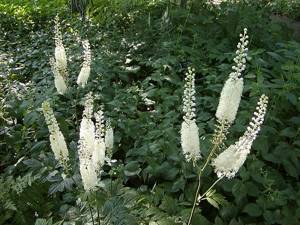
Racemose

James Compto
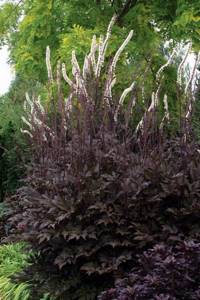
Branched Atropurpurea Black cohosh carbonella
Each type of black cohosh has clear, unique characteristics - flowering period, size, color.
Planting a plant
Black cohosh does better in shade or partial shade than in the sun. Contrary to popular belief, you should not plant it under trees. The perennial prefers soil rich in humus. The place must be protected from strong winds.

Black cohosh will decorate the shady areas of your garden with its flowering
Select planting time in autumn or spring. The depth of the hole is about 30 cm. Loosen the soil at the bottom and add organic matter. Keep the distance between plants at least 60 cm.
Advice. Cohosh does not really like transplanting and grows well in one place for 15-20 years.
Growing
Thanks to its decorative and beneficial properties, black cohosh is highly respected by gardeners. Growing a perennial plant is not difficult - black cohosh easily adapts to almost any conditions and does not have strict requirements for soil and lighting.
Planting black cohosh
Cohosh can be propagated by seeds or young seedlings. It is better to sow cohosh seeds in the spring, and young plants can be rooted in the open ground both in spring and autumn; the cohosh racemosa quickly takes root in a new place.
- The plant is characterized by increased endurance and tolerates almost any conditions. Black cohosh feels good in bright light, but in nature it often grows in shaded areas - therefore, in the garden it is better to choose a place protected from direct sunlight.
- It is better to choose nutritious and loose soil for black cohosh, so the perennial will grow stronger faster. Black cohosh also treats poor soils calmly, but does not like excessive moisture and stagnation of water. Therefore, the planting site must be well aerated; close proximity to groundwater is undesirable.
Before planting the plant in the ground, it is necessary to prepare the soil. To do this, the selected area is carefully dug up and a nutrient mixture consisting of peat, humus and a small amount of sand is added to the ground. You can also immediately add mineral fertilizers to the soil; in the first stages of growth, they will be very useful for black cohosh.
- The depth of the planting hole for the plant should be slightly greater than the root system of the young black cohosh; usually a hole is dug about 40 cm deep.
- Drainage is organized at the bottom of the planting hole - a layer of 8-10 cm of small pebbles, expanded clay or broken brick is poured. A small amount of nitrogen fertilizer is added to each hole.
- On top of the drainage, the hole is half filled with earth, and a black cohosh seedling is carefully lowered on top, trying not to damage the roots.
- The planting hole is filled to the top with soil, the soil is lightly compacted near the black cohosh stem, and then immediately watered with warm water.
- If you plan to plant several plants, you need to leave a sufficient distance of at least 60 cm between them - black cohosh grows quite quickly.

After planting and watering, it is recommended to mulch the soil with a layer of dry peat of several centimeters. A layer of mulch will not only deliver additional nutrients to the roots of black cohosh, but will also prevent premature evaporation of moisture.
Attention! The choice of location for black cohosh must be approached carefully from the point of view of landscape design. The lifespan of the perennial is 15-20 years, and adult black cohosh does not like to be transplanted from place to place; you need to start from the fact that black cohosh will remain in the chosen area for a long time.
Aftercare
Caring for black cohosh can be considered very simple. Basically it comes down to periodic watering and rare feeding of the plant.
- In spring and autumn, black cohosh usually needs natural soil moisture. However, during the dry summer months it is better to water the plant from time to time - black cohosh does not like serious drought. Watering is carried out infrequently - once every 3 weeks will be enough. But at the same time, you need to moisten the soil abundantly so that the water penetrates deeper into the soil - the roots of black cohosh are branched and long.
- After watering, the soil must be loosened so that more oxygen penetrates into the soil. In addition, regular loosening helps prevent the growth of weeds that negatively affect the health of black cohosh. Also, the soil at the roots can be mulched with straw or dry peat - this will reduce the frequency of weeding and watering.
- Black cohosh needs feeding immediately after planting; usually mineral fertilizers are applied directly into the planting hole. The first feeding of black cohosh lasts for a long time, up to 3 years of life, and subsequently the soil must be fertilized annually in early spring - it is recommended to use standard phosphorus, potassium and nitrogen substances. This stage is not obligatory - black cohosh grows quite well without additional feeding, however, with it, it blooms more luxuriantly and looks more decorative.
Since black cohosh does not belong to the category of heat-loving plants, it tolerates winter very well and does not require special care from gardeners. If severe cold and little snow are expected in winter, then black cohosh can simply be radically cut off at the root and buried with earth or covered with spruce branches. This will make it easier for black cohosh to overwinter, and in the spring it will produce new stems.
Pruning of a perennial plant can be done at will; usually, only wilted inflorescences are removed from the stems of cohosh in order to maintain the most decorative appearance.
Advice! As you can see in the photo of black cohosh, the stems of the plant are characterized by increased fragility and are afraid of strong winds. Therefore, the peculiarity of caring for black cohosh is that tall plants need to be tied to a support.

Black cohosh care
- The soil should be moist. More frequent watering is necessary during dry periods; it is reduced in the fall.
- Mulch black cohosh with leaves. This way you will not only retain moisture, but also protect the flowers from weeds.
- Inflorescences that fade should be cut off.
- It is better to tie up fragile black cohosh stems. This is especially true when caring for tall varieties.
- For the winter, the plant is covered with spruce branches or leaves. Before this, its stems must be completely cut off.
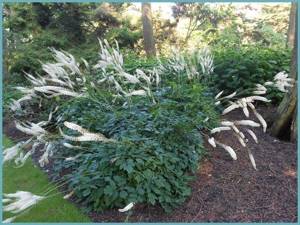
The plant will feel more comfortable if the soil under it is mulched.
Fertilizer and feeding of black cohosh
Cohosh loves fertile soil. During planting, add compost (7 cm layer) and sand (3 cm layer) to the hole. In the future, you need to feed black cohosh for more luxuriant flowering. Once a season will be enough.
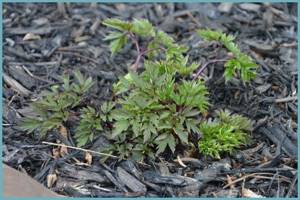
Black cohosh does not require frequent feeding
The time to apply fertilizer is early spring. You need to start from the third year after planting. Choose complex mineral supplements. They must contain nitrogen, phosphorus and potassium. For example, Kemira or Aelita Flower-1 fertilizers are suitable for nutritious watering.
Black cohosh: planting and care in open ground
There are several ways to plant black cohosh.
It is important to remember that black cohosh prefers fertile soil, so you should think about fertilizers and growth stimulants in advance. It is better to opt for complex mineral supplements needed by a young plant.
Growing by seeds
The most popular is classic sowing. This method is suitable if freshly harvested seeds are available. This is what guarantees the high germination rate of the perennial.
Since the seeds hatch for quite a long time, around 6 months, it is necessary to start planting at the beginning of winter. The soil should be chosen rich in organic and mineral substances. The container for seedlings does not need to be covered; the plant does not require high humidity
It is important to maintain the optimal room temperature, which should correspond to plus 20 degrees, after three months, the temperature should be gradually lowered
In the spring, when there is no chance of night frosts, the plant can be transplanted into open ground. Black cohosh grown by seed will begin to bloom no earlier than three years from the moment of planting. In the first years, only new leaves will appear on the bushes.
Black cohosh propagation
When breeding a flower for open ground, you can use bush division, cuttings or propagation by seeds.
- For division, take a bush that is at least 5-6 years old. A shoot or bud is separated from it, and the mother plant is planted back. The shoot is soaked in a stimulant, and then planted in a container and kept in a warm place. When it begins to grow, it is rooted in a permanent place in open ground. It's better to do this in the spring.

Black cohosh is easily propagated by dividing the bush and cuttings - Propagation by cuttings should also be carried out in the spring. In order not to disturb the root, separate the daughter bud that has sprouts. You can tear off a leaf near the stem; it must have a “heel” - a piece of the bark of the mother plant. The petiole is buried in the ground and covered, for example, with a plastic bottle.
- When propagating by seeds, it is better to use fresh material. It has the highest germination rate. Black cohosh can be sown either as seedlings or directly in open ground. Shoots appear in about six months. At the initial stage, it is necessary to ensure low soil moisture, otherwise the seeds may rot.

If you did not use the planting material right away, then it is better to postpone the procedure for 6 months. During this time, provide the seeds with special care, which will make growing easier. Before future sowing, black cohosh must be kept in the following conditions:
- first 3 months – at a temperature of +20 ˚C;
- next 3 months – at a temperature of +4 ˚C.
The plant, which is grown from seeds, blooms in 3-4 years.
Reproduction
The plant can be propagated by cuttings or seeds.
When planting using cuttings, a basal shoot with part of the root is used. It is necessary to keep the cuttings in the mixture for some time to stimulate growth. Next, you need to leave the shoot warm; a greenhouse is suitable for this, or you can cover it with glass or polyethylene until the perennial takes root. Next, planting occurs in open ground.
When using seed material, it must be sown immediately after collecting the seeds; this can increase the germination rate of the plant up to 100% (however, some gardeners note the possibility of rotting).
Sprouts will appear in six months if the correct temperature is maintained - the first 90 days are +20, then a gradual decrease to +4.
An important condition for normal plant development and good germination is the absence of moisture and maintaining the required temperature, while the likelihood of rotting is reduced to almost zero. Three or four years after planting in open ground, black cohosh will produce flowers.
Diseases and pests
The undeniable advantage of black cohosh is its resistance to diseases and insects. A sick flower is immediately visible. It withers, the leaves turn yellow, become spotted, and the flowering is not so abundant. If you notice that this is the result of pests, treat the black cohosh with a regular insecticide. The method of application of all fertilizers and preparations is usually indicated in the instructions.
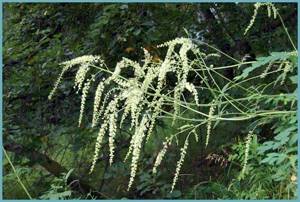
Black cohosh is disease resistant
Black cohosh may also suffer from rotting. But this is only the result of improper care. Do not overdo watering and do not mulch the soil at the base of the flower. Inspect your plants regularly to catch problems early.
Black cohosh in combination with other plants
Landscape design experts recommend choosing neighbors for cohosh who also like shade and moist soil. Hostas, aconite, buzulnik, Japanese anemone, and astilbe have similar growing conditions to black cohosh. Ferns and sedges will be an excellent addition to the landscape. The combination of black cohosh with red and purple flowers: columbine, lily, kupena looks harmonious, as if in a photo.

Black cohosh in the flowerbed
Climbing brunnera or lungwort, perennial moss and maple leaf can fill the empty spaces in the area with this plant. They will not allow the soil to dry out quickly, which is undesirable when growing and caring for black cohosh.
Low-growing saxifrage, tenacious or hoofweed will also retain soil moisture after watering or rain and will create a good ensemble with black cohosh. A beautiful composition with it is made up of low-growing conifers and bergenia, which will serve as a successful background.
Black cohosh in landscape design
You can plant black cohosh either alone or in a group, on a lawn or in a mixborder (mixed flower garden). When planting alone, it is better to choose tall varieties. For example, Dahurian or European cohosh, atropurpurea, etc. are suitable. For a rock garden, take black cohosh, which rarely grows above 80 cm.
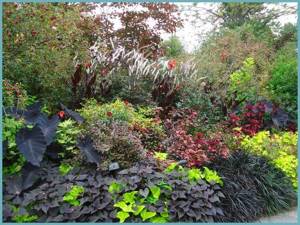
Black cohosh in landscape design
In landscape design, these plants are also used to decorate borders or flower beds. For this purpose, low-growing varieties of black cohosh are used (for example, Frau Herms). Often “silver candles” are planted in open ground near ponds, walls or fences. It should be borne in mind that they look especially attractive in the middle part of the flower garden. Florists are interested in growing and propagating black cohosh, because it looks great in autumn bouquets.
If you managed to appreciate all the beauty of black cohosh in the photo, then you will like it even more on your own site. The effort spent on planting and caring for it will not be in vain. After all, black cohosh is beautiful not only during the flowering period, but also after it. And with age, like a real woman, she only becomes more attractive.
Popular varieties of black cohosh
The black cohosh genus includes many species , each of which has its own characteristics, so it is these that you need to pay attention to when choosing an option for creating flower arrangements.
- Black cohosh is branched. This is a tall plant that can reach a height of 2 meters. During the growing season, it forms small cream-colored flowers that form large, elongated inflorescences. The leaves of this type of black cohosh have a variety of colors, which can be red-chocolate, bronze or dark cherry. Flowering occurs unusually late, unlike many plants - in September. However, if there is a lot of rainfall during the season, the plant may not have enough time to form inflorescences. Therefore, it is not advisable to choose an area in the shade for planting.
- Black cohosh is simple. The characteristic features of this plant are small drooping inflorescences, which are formed by small flowers. This variety of black cohosh is at its worst in cloudy summers, since in such conditions there is a high probability that it will not bloom. Within this group, it is worth highlighting the “Brunette” variety, which is in demand among many gardeners. It features bronze-chocolate foliage that maintains its rich hue throughout the season. Its white flowers, which turn purple when they bloom, are no less attractive.
- Black cohosh (cohosh racemosa). It is a tall perennial plant that usually reaches up to 2 meters in height. It is decorated with fragrant, candle-shaped inflorescences that open from bottom to top. Flowering begins in July and lasts until September. At this time of year, the plant transforms as white or cream-colored flowers begin to bloom.
- Black cohosh smells. This species differs from other species by the unpleasant odor that comes from the above-ground part of the rhizome. Many people know this variety under the name “Adam’s Rib”, and it is not by chance that it is worn, because its lower leaves strongly resemble ribs. The tallest are adult specimens, which can reach a height of 2 meters. The leaves of black cohosh are large and feathery. Small flowers, light green in color, are presented in the form of paniculate inflorescences.
- American black cohosh. This plant stands out for its impressive size, as it can grow up to 90-150 cm. As it grows, it forms thick, bright green leaves. Flowering begins in July and lasts until the end of August: at this stage it develops cylindrical cylindrical inflorescences that form flowers of a gray-beige hue.
- Black cohosh. Mature plants usually do not exceed 1 meter in height. The inflorescences have signs of pubescence and are presented in the form of branched long candles. Typically look a little droopy due to the small white flowers.
Read also: The best variety of remontant raspberries
All varieties of black cohosh have their own characteristics , differing from each other in terms of flowering, size and shade of inflorescences.








